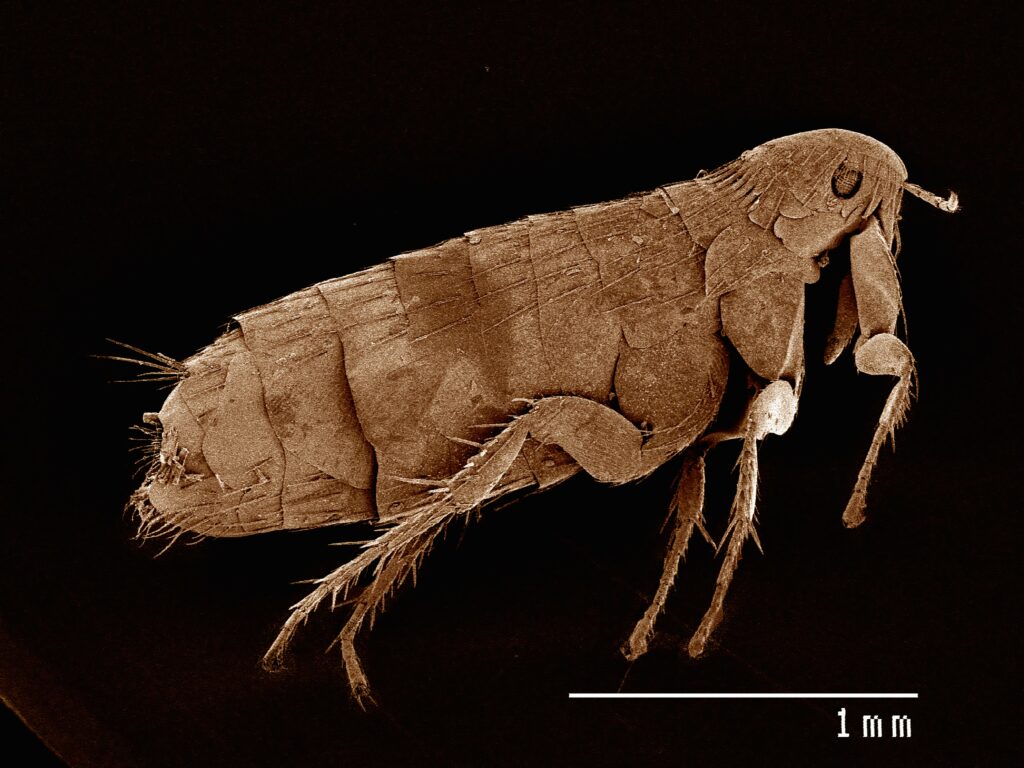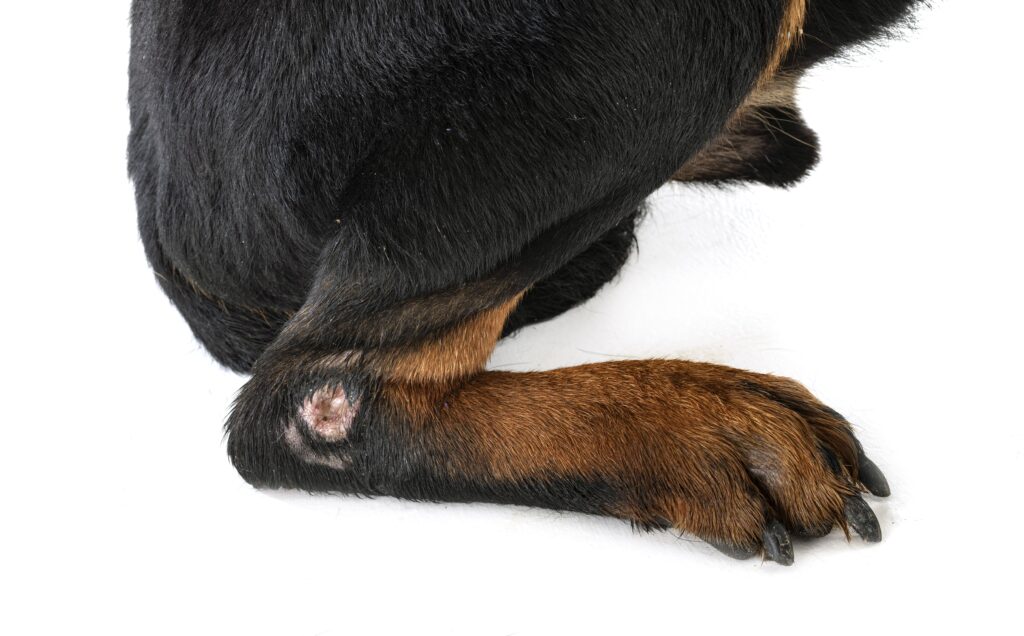Picture this: a serene afternoon spent lounging with your furry companion, relishing in the pure bliss of each other’s company. Suddenly, your tranquil scene is shattered as your pet’s incessant scratching and nibbling begins. You watch helplessly as they scratch their irritated skin raw and develop unsightly bald patches.
What could be causing this distress? The answer may lie in those tiny, pesky creatures known as fleas.
Flea allergies are a common affliction among our beloved pets, causing immense discomfort and wreaking havoc on their well-being. These minuscule pests possess remarkable capabilities to inflict misery through single flea bites.
Not all pets react adversely to flea bites; however, some animals have an allergic response to certain components present in the saliva of fleas. These allergy dermatitis reactions can range from mild irritation to severe inflammation and discomfort.
Understanding the symptoms and treatment options for flea allergies is crucial for pet owners who wish to alleviate their furry friends’ suffering effectively. By gaining insight into these aspects, we can recognize the signs of flea allergies early on and provide prompt relief to our pets when they need it most.
The Impact of Flea Allergies on Pets: More than Just Irritation

The impact of flea allergies extends far beyond mere irritation caused by relentless itching; it can cause significant distress for both pets and their owners alike. Flea allergy dermatitis in dogs, for example, can lead to hair loss, skin infections, and even behavioral changes due to constant discomfort. Cats are not exempt from this plight either; even feral cats are susceptible to the adverse effects of flea infestations.
Fleas not only cause intense itchiness but may also transmit various diseases or parasites that can further compromise the health of our furry companions. Therefore, understanding flea products and the implications of flea allergies is paramount in ensuring the well-being and happiness of our four-legged friends.
Unveiling the Key: Why Understanding Symptoms and Treatment Options Matters
When it comes to flea allergies, ignorance is anything but bliss. Recognizing the telltale signs of flea allergies is crucial for early intervention.
Itching, often localized on the lower back or around a dog’s legs, is one of the most prominent clinical signs of flea allergy dermatitis. Other indicators include hair loss, redness, swelling, and open sores caused by excessive scratching or biting.
Understanding symptoms allows pet owners to take prompt action to alleviate their pets’ discomfort through suitable treatment options. The array of available treatments ranges from oral medications to topical applications and even specialized diets designed to support skin health.
By staying informed about symptoms and treatment options for flea allergies in pets, we can effectively shield our furry companions from unnecessary suffering caused by these pesky critters. So let us embark on this enlightening journey that unravels the secrets behind symptoms and treatments for flea allergies – a quest that will ultimately restore comfort and joy to both pets and their devoted human counterparts.
Understanding Flea Allergies

Flea allergies, also known as flea allergy dermatitis (FAD), are hypersensitivity reactions that occur in pets, particularly dogs and cats, when exposed to the saliva of fleas. Fleas are tiny parasitic insects that feed on the blood of their hosts. When a flea bites an animal, it injects its saliva into the dog’s skin to prevent blood clotting.
In pets with flea allergies, their immune system overreacts to the proteins present in the saliva, triggering an allergic response. It’s important to note that not all animals will develop an allergic reaction to fleas; however, for those who do, even a small number of flea bites can cause severe discomfort.
Explanation of hypersensitivity reactions to flea saliva
When a pet with flea allergy dermatitis is bitten by a flea and exposed to its saliva proteins, their immune system mistakenly perceives these proteins as harmful invaders. This triggers an intense allergic response characterized by inflammation and itching in the affected area.
The primary allergen responsible for these reactions is a protein called histamine-like substance or histamine releaser found in high concentrations in flea saliva. Upon exposure to this allergen, sensitive dogs or cats release histamines from specialized cells called mast cells.
Histamines cause blood vessels near the site of exposure to dilate and become more permeable, leading to redness and swelling. This process also stimulates nerve endings in the skin that intensify itching sensations.
Prevalence in dogs and cats
Flea allergies are one of the most common dermatologic diseases affecting dogs and cats worldwide. In fact, it’s estimated that up to 40% of dogs experience some form of flea allergy dermatitis diagnosed with fleas being a significant trigger [cite].
The prevalence of flea eggs may vary based on a variety of factors including geographic location, climate, and the presence of feral animals in the area. It’s worth noting that flea allergies can affect any breed or age of dog or cat.
However, certain breeds of domestic dogs are predisposed to developing allergies due to genetic factors. Breeds such as Terriers, Bulldogs, and Retrievers tend to have a higher incidence of flea allergies compared to others.
Additionally, animals with compromised immune systems or pre-existing skin diseases like atopic dermatitis are more prone to developing flea allergies. To prevent and manage flea allergies effectively, it’s crucial for pet owners to understand the symptoms associated with this condition and seek timely veterinary care.
Symptoms of Flea Allergies
When it comes to identifying whether your beloved furry friend is suffering from flea allergies, it’s essential to be on the lookout for some telltale signs. Pets with flea allergies often exhibit a range of clinical signs that can vary in intensity. The most prominent indicator treat flea allergy dermatitis is intense itching and scratching.
You might notice your pet relentlessly scratching or gnawing at their skin, primarily around the hindquarters, base of the tail, and abdomen. This incessant scratching can lead to hair loss and the development of painful skin lesions.
Intense itching and scratching

One of the primary symptoms of flea allergies in pets is intense itching, which occurs due to an allergic reaction against flea saliva injected during feeding. Even a single bite from a flea can trigger an allergic reaction in sensitive animals, resulting in significant discomfort.
Dogs and cats affected by flea allergies can scratch themselves raw as they attempt to make flea dirt alleviate their itching sensation. They may chew at their paws or scratch vigorously at their ears and necks, leading to visible redness, inflammation, and discomfort.
Hair loss and skin lesions

Hair loss (alopecia) is another common symptom seen in pets suffering from flea allergies. Due to incessant scratching and biting at their fur, patches of hair may become thin or completely fall out over time. Moreover, these constant self-inflicted wounds can lead to the formation of open sores or skin lesions that may ooze or crust over time.
These lesions are susceptible to secondary bacterial infections that cause further complications for our furry companions. Overall, recognizing these symptoms is crucial for timely diagnosis and effective treatment for your pet’s comfort and well-being.
Diagnosis of Flea Allergies
Veterinary examination and history taking

When it comes to both flea control and diagnosing flea allergies in pets, seeking the expertise of a veterinarian is essential. A thorough veterinary examination and history-taking are the first steps in identifying whether your furry friend is suffering from flea allergy dermatitis (FAD).
During the examination, the vet will carefully inspect your pet’s skin for any signs of irritation, redness, or lesions. They will also inquire about your pet’s medical history, including any previous incidences of fleas or allergic reactions.
Identifying fleas or their feces on the pet’s body or bedding
To confirm a diagnosis of flea allergies, it is crucial to find evidence of fleas on your pet’s body or bedding. Fleas themselves are tiny insects that can be challenging to spot due to their quick movements and small size. However, diligent observation can help uncover their presence.
Look for small brownish-black insects moving through your pet’s fur or examine areas where fleas commonly gather such as around the ears, neck, and tail base. Additionally, inspecting your pet’s bedding for flea feces can provide further evidence of an infestation.
Additional tests to rule out other skin conditions
To ensure an accurate diagnosis and rule out other potential skin diseases with similar symptoms as flea allergy dermatitis (FAD), veterinarians may recommend additional tests. These tests aim to eliminate other possible causes for your pet’s discomfort such as bacterial infections or other common dermatologic diseases. One commonly used diagnostic tool is intradermal allergy testing which involves injecting small amounts of potential allergens under the skin surface to the skin tests to determine if a delayed reaction occurs.
Another option is specialized blood tests that measure specific immunoglobulin E (IgE) antibodies in response to various allergens. These tests can help identify any other allergies your pet might have or confirm the presence of flea allergies.
It’s important to remember that while these additional tests can provide valuable information on developing flea allergy dermatitis, a diagnosis of flea allergies is often based on clinical signs and response to treatment. Therefore, a comprehensive examination by a veterinarian remains the cornerstone for accurately diagnosing and treating flea allergy dermatitis in our beloved pets.
Treatment Options for Flea Allergies
When it comes to flea allergies, prevention plays an essential role in keeping our furry friends comfortable and healthy. Regular use of flea preventatives is crucial for breaking the flea life cycle and preventing infestations. Thankfully, there are various options available to help us accomplish this.
Topical treatments (spot-on)
One effective method of preventing flea allergies is through topical treatments, commonly known as spot-on treatments. These products are applied directly to your pet’s skin, usually between the shoulder blades or along the backline.
They contain active ingredients that kill fleas upon contact and provide month-long protection against infestations. Topical treatments are easy to apply and come in different formulations suitable for both dogs and cats.
Oral medications (chewable tablets)

Another convenient option for flea prevention is through oral medications in the form of chewable tablets. These medications contain ingredients that circulate in your pet’s bloodstream, effectively killing fleas when they bite.
They provide systemic protection against fleas throughout their lifecycle and are highly recommended by veterinarians due to their efficacy. Oral meds offer a hassle-free approach as they eliminate the need for topical application.
Collars infused with insecticides

Collars infused with insecticides have also proven effective in preventing fleas from bothering our beloved pets. These collars release active ingredients that repel and kill fleas upon contact with your pet’s fur, offering long-lasting protection against infestations.
With adjustable sizes available for both dogs and cats, these flea collars can provide a convenient solution while ensuring ongoing protection against these pesky parasites. Cleaning the pet’s environment by regularly washing bedding, vacuuming carpets, and frequently cleaning areas where pets spend time significantly reduces the risk of flea infestations.
By doing so, we remove fleas, their eggs, and flea excrement that may be lurking in our homes. It’s important to focus on areas where pets rest or sleep, as fleas tend to concentrate in these locations.
Treating existing infestations
If an unfortunate situation arises where your pet has already fallen victim to a severe flea infestation or developed symptoms of flea allergies, prompt action, and rigorous flea treatment is crucial. Here are some effective treatment options to consider:
When tackling existing infestations of adult fleas, using shampoos containing insecticides or natural ingredients like neem oil can help eliminate fleas from your pet’s body. These shampoos should be specifically formulated for killing and repelling fleas while being gentle on your pet’s skin.
In cases of more severe flea infestations or persistent allergic reactions, prescription-strength topical treatments prescribed by veterinarians may be necessary. These specialized products contain potent ingredients that effectively target and eradicate fleas while providing relief for your pet’s irritated skin.
To alleviate the discomfort caused by flea allergies, veterinarians may recommend medications such as steroids or antihistamines to reduce itching and inflammation. Additionally, incorporating omega-3 fatty acids into your pet’s diet can help promote healthy skin and decrease the severity of allergic reactions.
Conclusion
Tackling flea allergies requires a comprehensive approach encompassing prevention and proper treatment. By utilizing topical preventatives like spot-on treatments or oral medications along with collars infused with insecticides, we can effectively protect our furry companions from the most common external parasite: fleas. Additionally, maintaining cleanliness in our pet’s environment significantly reduces the risk of flea infestations occurring.
In cases where treatment is necessary, shampoos, prescription-strength topical treatments, and medications or supplements can provide relief from symptoms and restore our pets’ comfort. Remember, with the right preventive measures and prompt action when needed, we can ensure a happier, itch-free life for our cherished pets.
Get rid of fleas with D-Termination: Las Vegas’ top-tier pest control service!

If you’re contending with flea issues on your Las Vegas property, rely on D-Termination for assistance. Our expert team excels in eliminating flea infestations and restoring comfort and peace to your space. Say farewell to fleas—opt for D-Termination for effective pest control today!
Contact us at 702-919-6310 or visit dtermination.com to schedule your flea control service and reclaim your space from these bothersome pests.
Frequently Asked Questions:
Treatment for an allergic reaction to fleas involves antihistamines, corticosteroids, and addressing the underlying flea infestation.
The best medicine for flea allergy dermatitis may include prescribed medications such as corticosteroids or antihistamines, recommended by a veterinarian.
Symptoms of flea allergies in humans can include itching, redness, and skin irritation at the bite site.
The duration for flea allergy dermatitis to go away varies but can take weeks with proper treatment and flea control.








